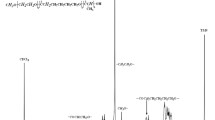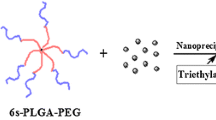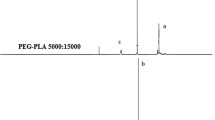Abstract
Formulation optimization from the early steps plays an important role in the success of drug delivery system development. To optimize nano-sized micelles based on poly(ethylene glycol)-b-poly(lactide)-b-poly(ethylene glycol) (PEG-PLA-PEG) triblock copolymers, the effect of PLA composition on the physicochemical properties of micelles was studied. Doxorubicin (DOX) was used to be encapsulated into micelles. In vitro studies on the safety of triblock copolymers and cytotoxicity of DOX-loaded micelles compared to free DOX were done, using MDA-MB-231 cells. Critical micelle concentration and micelle size were found to be linearly dependent on the PLA molecular weight (MW). In addition, it was shown that long PLA-containing micelles had low stability. The sizes of DOX-loaded micelles were bigger than those of empty micelles. The loading amount of DOX into micelles as well as the release rate of DOX from micelles depended on the PLA MW. Triblock copolymers themselves did not show any toxicity over a wide range of concentration. DOX-loaded micelles killed more tumor cells than free DOX. In summary, difference in hydrophobicity can be a critical factor to determine the physicochemical properties of micelles composed of PEG-PLA-PEG, and thus, it can affect the drug delivery efficacy of micelles. After considering all related factors, PEG-PLA-PEG 2 kDa-6 kDa-2 kDa seemed to be the best polymer for further studies.







Similar content being viewed by others
References
Cho K, Wang X, Nie S, Shin DM (2008) Therapeutic nanoparticles for drug delivery in cancer. Clin Cancer Res 14(5):1310–1316
Zhang L, Gu F, Chan J, Wang A, Langer R, Farokhzad O (2008) Nanoparticles in medicine: therapeutic applications and developments. Clin Pharmacol Ther 83(5):761–769
Kataoka K, Harada A, Nagasaki Y (2001) Block copolymer micelles for drug delivery: design, characterization and biological significance. Adv Drug Deliver Rev 47(1):113–131
Gaucher G, Dufresne MH, Sant VP, Kang N, Maysinger D, Leroux JC (2005) Block copolymer micelles: preparation, characterization and application in drug delivery. J Control Release 109(1):169–188
Adams ML, Lavasanifar A, Kwon GS (2003) Amphiphilic block copolymers for drug delivery. J Pharm Sci 92(7):1343–1355
Torchilin VP (2007) Micellar nanocarriers: pharmaceutical perspectives. Pharm Res 24(1):1–16
Rösler A, Vandermeulen GW, Klok H-A (2012) Advanced drug delivery devices via self-assembly of amphiphilic block copolymers. Adv Drug Deliver Rev 64:270–279
Allen C, Maysinger D, Eisenberg A (1999) Nano-engineering block copolymer aggregates for drug delivery. Colloid Surf B 16(1):3–27
Yamaoka T, Tabata Y, Ikada Y (1994) Distribution and tissue uptake of poly (ethylene glycol) with different molecular weights after intravenous administration to mice. J Pharm Sci 83(4):601–606
Zhang Z, Lee SH, Feng S-S (2007) Folate-decorated poly (lactide-co-glycolide)-vitamin E TPGS nanoparticles for targeted drug delivery. Biomaterials 28(10):1889–1899
Oh JK (2011) Polylactide (PLA)-based amphiphilic block copolymers: synthesis, self-assembly, and biomedical applications. Soft Matter 7(11):5096–5108
Nampoothiri KM, Nair NR, John RP (2010) An overview of the recent developments in polylactide (PLA) research. Bioresour Technol 101(22):8493–8501
Rasal RM, Janorkar AV, Hirt DE (2010) Poly (lactic acid) modifications. Prog Polym Sci 35(3):338–356
Jain AK, Goyal AK, Mishra N, Vaidya B, Mangal S, Vyas SP (2010) PEG–PLA–PEG block copolymeric nanoparticles for oral immunization against hepatitis B. Int J Pharm 387(1):253–262
Jeong B, Bae YH, Lee DS, Kim SW (1997) Biodegradable block copolymers as injectable drug-delivery systems. Nature 388(6645):860–862
Yun JM, Park S-Y, Lee ES, Youn YS, Park GY, Lim C, Lee B-J, Song H-T, Oh YT, Oh KT (2012) Physicochemical characterizations of amphiphilic block copolymers with different MWs and micelles for development of anticancer drug nanocarriers. Macromol Res 1–10
Jain AK, Goyal AK, Gupta PN, Khatri K, Mishra N, Mehta A, Mangal S, Vyas SP (2009) Synthesis, characterization and evaluation of novel triblock copolymer based nanoparticles for vaccine delivery against hepatitis B. J Control Release 136(2):161–169
He G, Ma LL, Pan J, Venkatraman S (2007) ABA and BAB type triblock copolymers of PEG and PLA: a comparative study of drug release properties and “stealth” particle characteristics. Int J Pharm 334(1):48–55
Monzen M, Kawakatsu T, Doi M, Hasegawa R (2000) Micelle formation in triblock copolymer solutions. Comput Theor Polym Sci 10(3):275–280
Shan X, Yuan Y, Liu C, Xu F, Sheng Y (2009) Comparison of the PLA-mPEG and mPEG-PLA-mPEG copolymers nanoparticles on the plasma protein adsorption and in vivo biodistribution. Soft Matter 5(15):2875–2883
Song H-T, Hoang NH, Yun JM, Park YJ, Song EH, Lee ES, Youn YS, Oh KT (2016) Development of a new tri-block copolymer with a functional end and its feasibility for treatment of metastatic breast cancer. Colloid Surf B 144:73–80
Oh KT, Yun JM (2015) BAB-type tri-block copolymer comprising polylactic acid (A) and polyethylene glycol (B), method for producing same, and drug delivery system using same. US Patent Patent US9125944 B2
Yasugi K, Nagasaki Y, Kato M, Kataoka K (1999) Preparation and characterization of polymer micelles from poly (ethylene glycol)-poly (d, l-lactide) block copolymers as potential drug carrier. J Control Release 62(1):89–100
Lysenko EA, Bronich TK, Slonkina EV, Eisenberg A, Kabanov VA, Kabanov AV (2002) Block ionomer complexes with polystyrene core-forming block in selective solvents of various polarities. 1. Solution behavior and self-assembly in aqueous media. Macromolecules 35(16):6351–6361
Han SK, Na K, Bae YH (2003) Sulfonamide based pH-sensitive polymeric micelles: physicochemical characteristics and pH-dependent aggregation. Colloid Surf A 214(1):49–59
Ebrahim Attia AB, Ong ZY, Hedrick JL, Lee PP, Ee PLR, Hammond PT, Yang YY (2011) Mixed micelles self-assembled from block copolymers for drug delivery. Curr Opin Colloid Interface Sci 16(3):182–194
Rapoport N (2007) Physical stimuli-responsive polymeric micelles for anti-cancer drug delivery. Prog Polym Sci 32(8):962–990
Wiradharma N, Zhang Y, Venkataraman S, Hedrick JL, Yang YY (2009) Self-assembled polymer nanostructures for delivery of anticancer therapeutics. Nano Today 4(4):302–317
Kalyanasundaram K, Thomas J (1977) Environmental effects on vibronic band intensities in pyrene monomer fluorescence and their application in studies of micellar systems. J Am Chem Soc 99(7):2039–2044
Lee ES, Shin HJ, Na K, Bae YH (2003) Poly (l-histidine)–PEG block copolymer micelles and pH-induced destabilization. J Control Release 90(3):363–374
Shuai X, Ai H, Nasongkla N, Kim S, Gao J (2004) Micellar carriers based on block copolymers of poly (ε-caprolactone) and poly (ethylene glycol) for doxorubicin delivery. J Control Release 98(3):415–426
Gu F, Zhang L, Teply BA, Mann N, Wang A, Radovic-Moreno AF, Langer R, Farokhzad OC (2008) Precise engineering of targeted nanoparticles by using self-assembled biointegrated block copolymers. Proc Natl Acad Sci 105(7):2586–2591
Sparreboom A, Scripture CD, Trieu V, Williams PJ, De T, Yang A, Beals B, Figg WD, Hawkins M, Desai N (2005) Comparative preclinical and clinical pharmacokinetics of a cremophor-free, nanoparticle albumin-bound paclitaxel (ABI-007) and paclitaxel formulated in Cremophor (Taxol). Clin Cancer Res 11(11):4136–4143
Gelderblom H, Verweij J, Nooter K, Sparreboom A (2001) Cremophor EL: the drawbacks and advantages of vehicle selection for drug formulation. Eur J Cancer 37(13):1590–1598
De Verdiere AC, Dubernet C, Nemati F, Poupon M, Puisieux F, Couvreur P (1994) Uptake of doxorubicin from loaded nanoparticles in multidrug-resistant leukemic murine cells. Cancer Chemother Pharm 33(6):504–508
Acknowledgments
This work was supported by the National Research Foundation of Korea (NRF) Grant funded by the Korea government (MSIP) (NRF-2014R1A2A1A11050094 and 2015R1A5A1008958) and a Grant (16173MFDS542) from the Ministry of Food and Drug Safety in 2016.
Author information
Authors and Affiliations
Corresponding author
Ethics declarations
Conflict of interest
The authors declare that there is no conflict of interest.
Rights and permissions
About this article
Cite this article
Hoang, N.H., Lim, C., Sim, T. et al. Characterization of a triblock copolymer, poly(ethylene glycol)-polylactide-poly(ethylene glycol), with different structures for anticancer drug delivery applications. Polym. Bull. 74, 1595–1609 (2017). https://doi.org/10.1007/s00289-016-1791-3
Received:
Revised:
Accepted:
Published:
Issue Date:
DOI: https://doi.org/10.1007/s00289-016-1791-3




